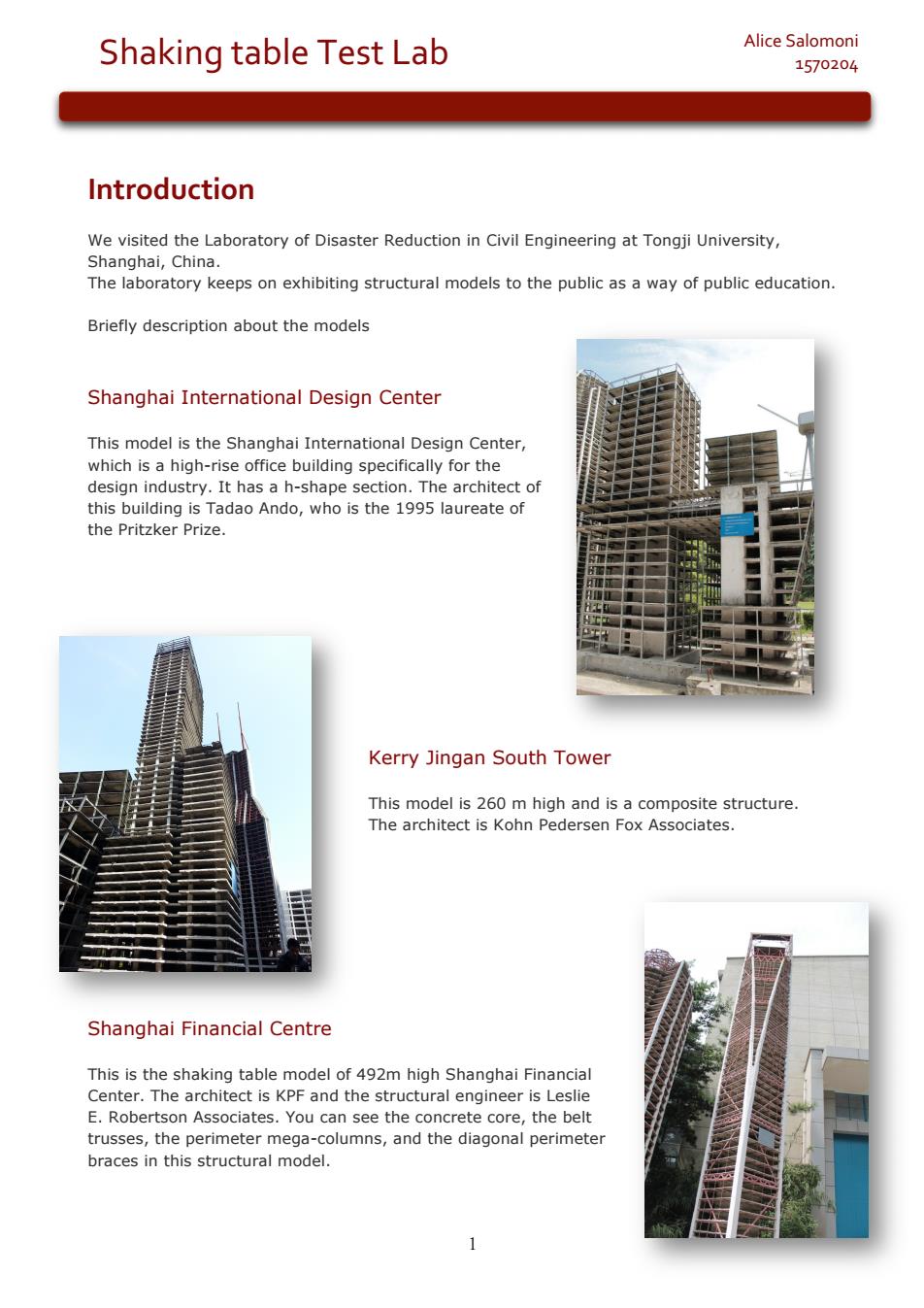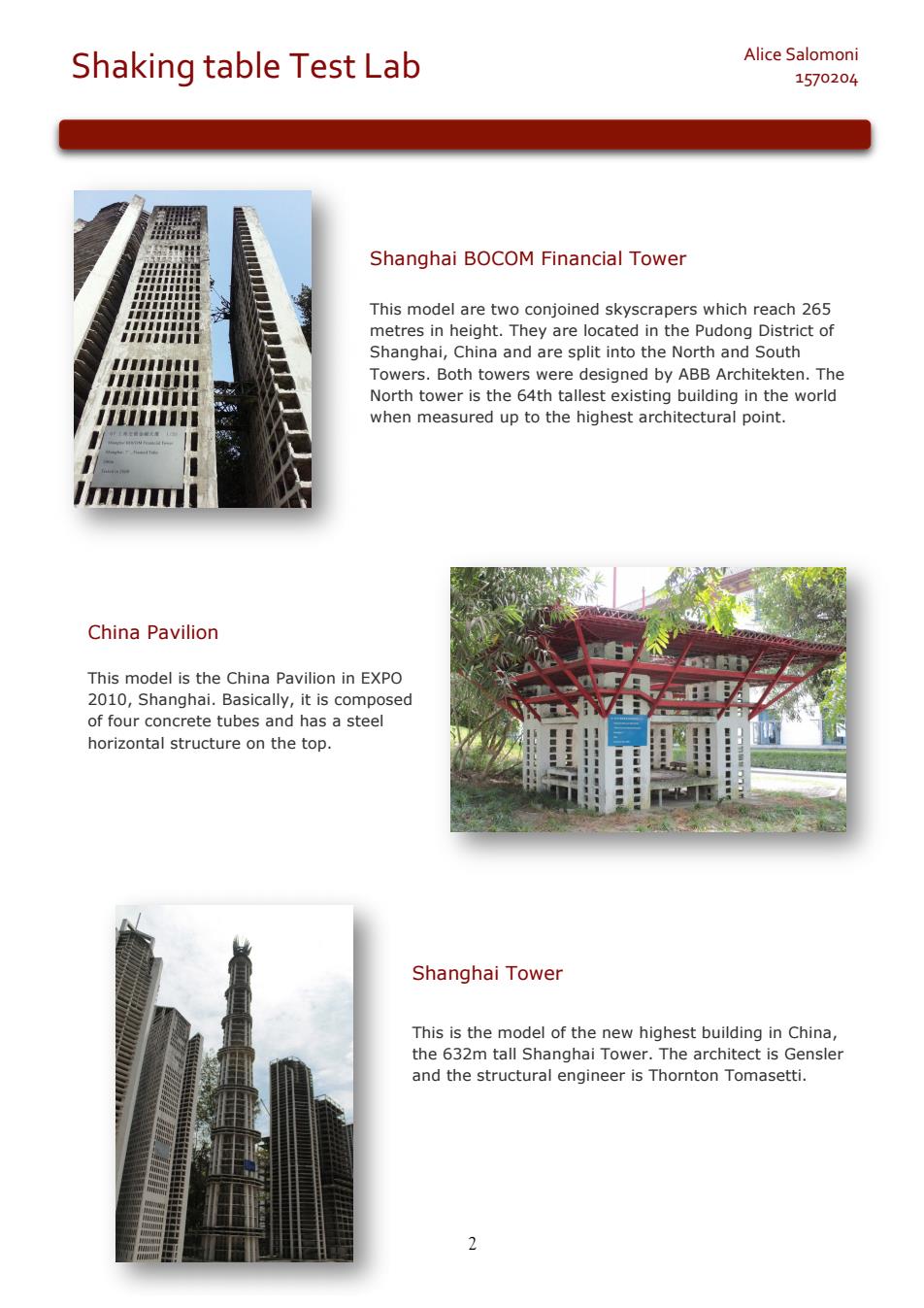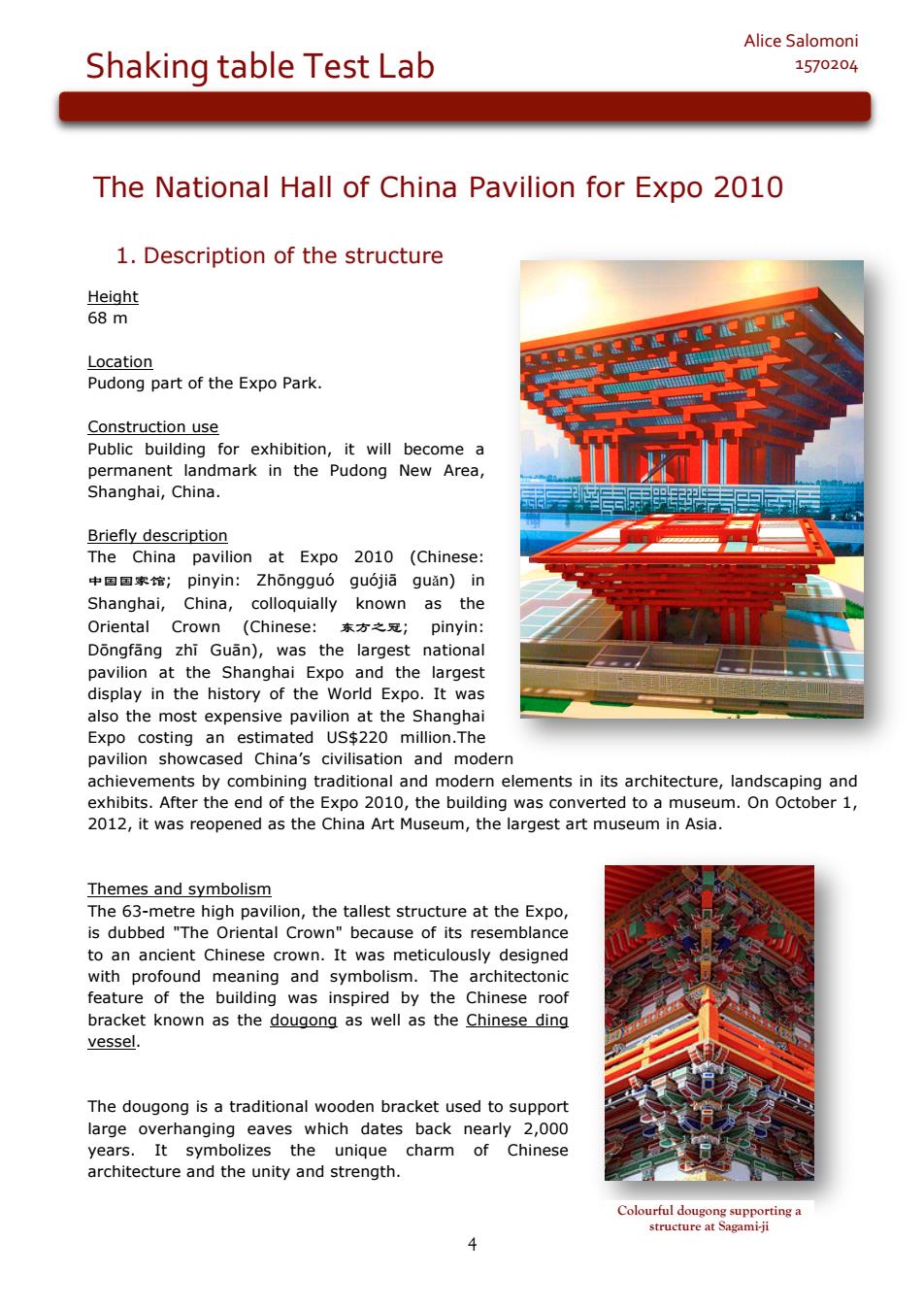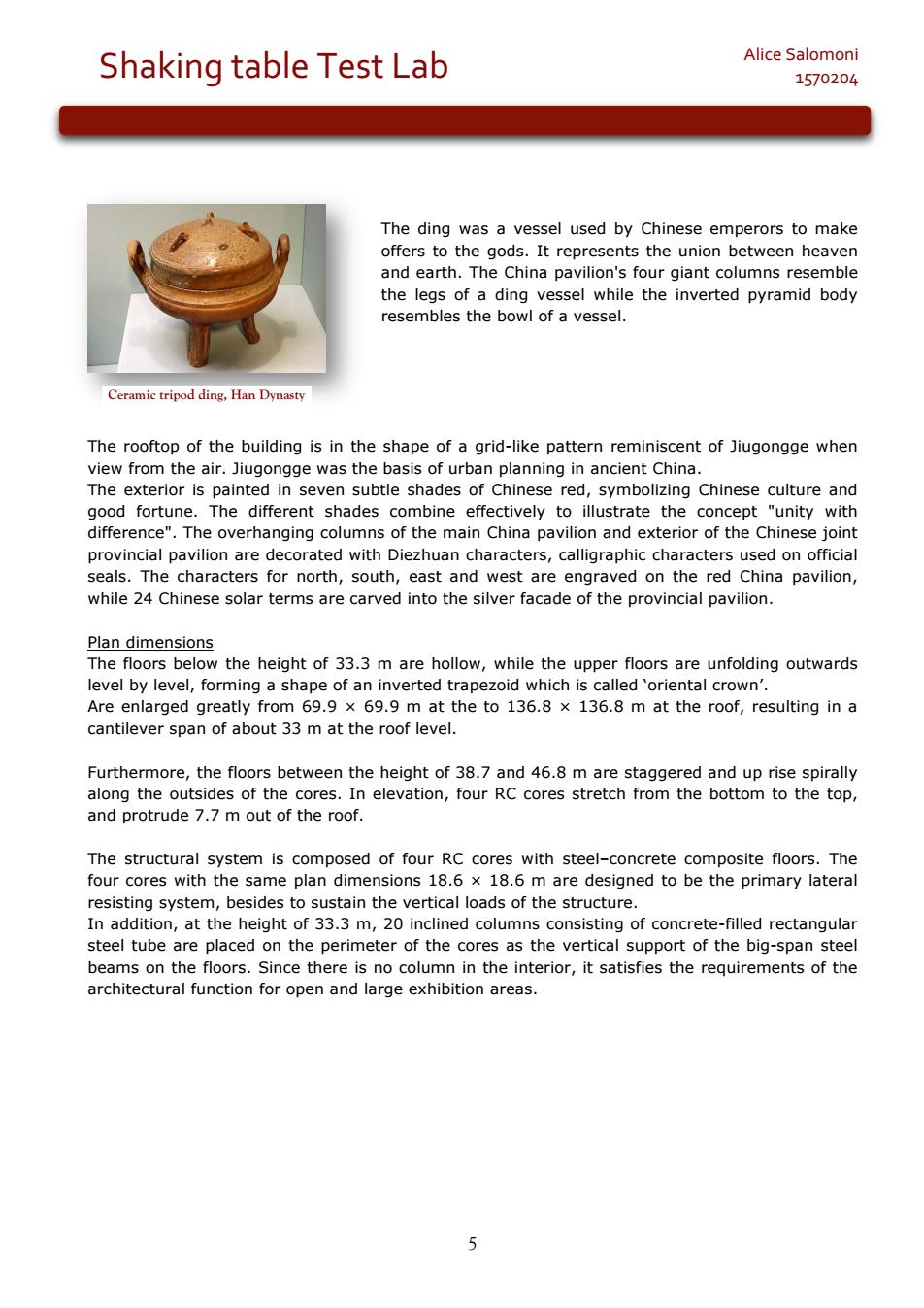
Shaking table Test Lab Alice Salomoni 1570204 Introduction keeps on exhibiting structural models to the public as a way of public education. Briefly description about the models Shanghai International Design Center This model is the Shanghai International Design Center, which is a high-rise office building specifically for the design industry.It has a h-shape section.The architect of this building is Tadao Ando,who is the 1995 laureate of the Pritzker Prize. Kerry Jingan South Tower This model is 260 m high and is a composite structure The architect is Kohn Pedersen Fox Associates. Shanghai Financial Centre This is the shaking table model of 492m high Shanghai Financial ct is KPF and the structural engineer is Lesi perimete
1 Alice Salomoni Shaking table Test Lab 1570204 Introduction We visited the Laboratory of Disaster Reduction in Civil Engineering at Tongji University, Shanghai, China. The laboratory keeps on exhibiting structural models to the public as a way of public education. Briefly description about the models Shanghai International Design Center This model is the Shanghai International Design Center, which is a high-rise office building specifically for the design industry. It has a h-shape section. The architect of this building is Tadao Ando, who is the 1995 laureate of the Pritzker Prize. Kerry Jingan South Tower This model is 260 m high and is a composite structure. The architect is Kohn Pedersen Fox Associates. Shanghai Financial Centre This is the shaking table model of 492m high Shanghai Financial Center. The architect is KPF and the structural engineer is Leslie E. Robertson Associates. You can see the concrete core, the belt trusses, the perimeter mega-columns, and the diagonal perimeter braces in this structural model

Shaking table Test Lab Alice Salomoni 1570204 Shanghai BOCOM Financial Tower This model are two conjoined skyscrapers which reach 265 metres in height.They are located in the Pudong District of Shanghai,China and are split into the North and South Towers.Both towers were designed by ABB Architekten.The rtn tower is the t 4th tallest existing building in the world when measured up to the highest architectural point China Pavilion This model is the China Pavilion in EXPO 2010,Shanghai.Basically,it is composed of four concrete tubes and has a steel horizontal structure on the top. Shanghai Tower This is the model of the new highest building in China, the 632m tall Shanghai Tower.The architect is Gensler and the structural engineer is Thornton Tomasetti
2 Shaking table Test Lab Alice Salomoni 1570204 Shanghai BOCOM Financial Tower This model are two conjoined skyscrapers which reach 265 metres in height. They are located in the Pudong District of Shanghai, China and are split into the North and South Towers. Both towers were designed by ABB Architekten. The North tower is the 64th tallest existing building in the world when measured up to the highest architectural point. China Pavilion This model is the China Pavilion in EXPO 2010, Shanghai. Basically, it is composed of four concrete tubes and has a steel horizontal structure on the top. Shanghai Tower This is the model of the new highest building in China, the 632m tall Shanghai Tower. The architect is Gensler and the structural engineer is Thornton Tomasetti

Shaking table Test Lab Alice Salomoni 1570204 Shimao International Plaza model of Shimao International Plaza,which 3m ta on the The StUctralenginersBuroHapoldconsutingEnginerS
3 Alice Salomoni Shaking table Test Lab 1570204 Shimao International Plaza This is the model of Shimao International Plaza, which is a 333m tall skyscraper lies in the famous Nanjing Road. The architect is Ingenhoven, Overdiek und Partner and the structural engineer is Buro Happold Consulting Engineers

Alice Salomoni Shaking table Test Lab 1570204 The National Hall of China Pavilion for Expo 2010 1.Description of the structure aptoteEoat Shangal,China. Pudong Briefly description The China pavilion at Expo 2010 (Chinese: 中泰馆;pinyin:Zhonggu6gu6 jia guan)in Shanghai, Chi uially the (Chinese: pinyin 2 n), the lar nationa he pla histon th xpe ISs at sh ed Ch nts by After 2012,it was reopened as the China Art Museum,the largest art museum in Asia. Themes and symbolism The 63-metre high pavilion,the tallest structure at the Expo is dubbed "The Oriental Crown"because of its resemblance to an ancient Chinese crown.It was meticulously designed with profound meaning and symbolism.The architectonic feature of the building was inspired by the Chinese roof bracket known as the dougong as well as the Chinese ding vessel. The dougong is a traditional wooden bracket used to support large overhanging eaves which dates back nearly 2,000 It sy izes the charm of ing a
4 Alice Salomoni Shaking table Test Lab 1570204 The National Hall of China Pavilion for Expo 2010 1. Description of the structure Height 68 m Location Pudong part of the Expo Park. Construction use Public building for exhibition, it will become a permanent landmark in the Pudong New Area, Shanghai, China. Briefly description The China pavilion at Expo 2010 (Chinese: 中国国家馆; pinyin: Zhōngguó guójiā guǎn) in Shanghai, China, colloquially known as the Oriental Crown (Chinese: 东方之冠; pinyin: Dōngfāng zhī Guān), was the largest national pavilion at the Shanghai Expo and the largest display in the history of the World Expo. It was also the most expensive pavilion at the Shanghai Expo costing an estimated US$220 million.The pavilion showcased China’s civilisation and modern achievements by combining traditional and modern elements in its architecture, landscaping and exhibits. After the end of the Expo 2010, the building was converted to a museum. On October 1, 2012, it was reopened as the China Art Museum, the largest art museum in Asia. Themes and symbolism The 63-metre high pavilion, the tallest structure at the Expo, is dubbed "The Oriental Crown" because of its resemblance to an ancient Chinese crown. It was meticulously designed with profound meaning and symbolism. The architectonic feature of the building was inspired by the Chinese roof bracket known as the dougong as well as the Chinese ding vessel. The dougong is a traditional wooden bracket used to support large overhanging eaves which dates back nearly 2,000 years. It symbolizes the unique charm of Chinese architecture and the unity and strength. Colourful dougong supporting a structure at Sagami-ji

Shaking table Test Lab Alice Salomoni 1570204 S between heave eramic tripod ing Han Dynas The rooftop of the building is in the shape of a grid-like pattern reminiscent of Jiugongge when view from the air.Jiugongge was the basis of urban planning in ancient China. The exterior is painted in seven subtle shades of Chinese red,symbolizing Chinese culture and good fortune.The different shades combine effectively to illustrate the concept "unity with difference".The overhanging columns of the main China pavilion and exterior of the Chinese joint provincial pavilion are decorated with Diezhuan characters,calligraphic characters used on official seals.The characters for north,south,east and west are engraved on the red China pavilion, while 24 Chinese solar terms are carved into the silver facade of the provincial pavilion. Plan dimensions evel by eelow the height of33 mrewele crown m a m at the resulting in a de elevation,four ores top The structural system is co es with steel- resisting system.besides to sustain the vertical loads of the structure In addition at the heiaht of 33 3 m 20 inclined columns consisting of concrete-filled rectangula steel tube are placed on the perimeter of the cores as the vertical support of the big-span steel beams on the floors.Since there is no column in the interior,it satisfies the requirements of the architectural function for open and large exhibition areas
5 Alice Salomoni Shaking table Test Lab 1570204 The ding was a vessel used by Chinese emperors to make offers to the gods. It represents the union between heaven and earth. The China pavilion's four giant columns resemble the legs of a ding vessel while the inverted pyramid body resembles the bowl of a vessel. The rooftop of the building is in the shape of a grid-like pattern reminiscent of Jiugongge when view from the air. Jiugongge was the basis of urban planning in ancient China. The exterior is painted in seven subtle shades of Chinese red, symbolizing Chinese culture and good fortune. The different shades combine effectively to illustrate the concept "unity with difference". The overhanging columns of the main China pavilion and exterior of the Chinese joint provincial pavilion are decorated with Diezhuan characters, calligraphic characters used on official seals. The characters for north, south, east and west are engraved on the red China pavilion, while 24 Chinese solar terms are carved into the silver facade of the provincial pavilion. Plan dimensions The floors below the height of 33.3 m are hollow, while the upper floors are unfolding outwards level by level, forming a shape of an inverted trapezoid which is called ‘oriental crown’. Are enlarged greatly from 69.9 × 69.9 m at the to 136.8 × 136.8 m at the roof, resulting in a cantilever span of about 33 m at the roof level. Furthermore, the floors between the height of 38.7 and 46.8 m are staggered and up rise spirally along the outsides of the cores. In elevation, four RC cores stretch from the bottom to the top, and protrude 7.7 m out of the roof. The structural system is composed of four RC cores with steel–concrete composite floors. The four cores with the same plan dimensions 18.6 × 18.6 m are designed to be the primary lateral resisting system, besides to sustain the vertical loads of the structure. In addition, at the height of 33.3 m, 20 inclined columns consisting of concrete-filled rectangular steel tube are placed on the perimeter of the cores as the vertical support of the big-span steel beams on the floors. Since there is no column in the interior, it satisfies the requirements of the architectural function for open and large exhibition areas. Ceramic tripod ding, Han Dynasty